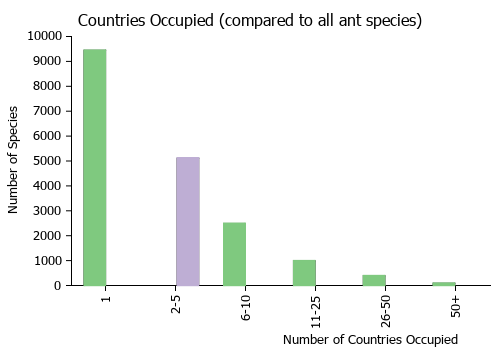Nylanderia natalensis
| Nylanderia natalensis | |
|---|---|

| |
| Scientific classification | |
| Kingdom: | Animalia |
| Phylum: | Arthropoda |
| Class: | Insecta |
| Order: | Hymenoptera |
| Family: | Formicidae |
| Subfamily: | Formicinae |
| Tribe: | Lasiini |
| Genus: | Nylanderia |
| Species: | N. natalensis |
| Binomial name | |
| Nylanderia natalensis (Forel, 1915) | |
Identification
Worker diagnosis: Overall brown, with abundant pubescence on head, anterior portions of pronotum, mesonotum and gaster.
Compare with: Nylanderia jaegerskioeldi
Workers of N. natalensis and N. jaegerskioeldi are impossible to reliably tell apart from each other. It appears that N. natalensis is slightly less pubescent than N. jaegerskioeldi, but this is hard to qualify, and we have not always found it a reliable diagnostic feature. An interesting point, however, is that the male genitalia of these two species are very different, especially the size and shape of volsella and the associated lobes. Males of each are easily distinguishable. The digiti and cuspi of N. natalensis are similar in structure to Nylanderia boltoni, Nylanderia lepida, and Nylanderia silvula. In these species, the cuspi are lobe-like and not nearly as wide as the digiti, and in general fairly typical in appearance for what is observed in Nylanderia species in other parts of the world. In N. jaegerskioeldi the cuspi are much larger than the digiti and paddle-like; additionally the digiti are thin and blade-like, an unusual shape for Nylanderia digiti. There are differences in the paramere shape as well between N. natalensis and N. jaegerskioeldi. In N. natalensis the paramere margin is broadly rounded, whereas N. jaegerskioeldi has a finger-like extension of the margin.
Keys including this Species
Distribution
Latitudinal Distribution Pattern
Latitudinal Range: -17.66667° to -33.56°.
| North Temperate |
North Subtropical |
Tropical | South Subtropical |
South Temperate |
- Source: AntMaps
Distribution based on Regional Taxon Lists
Afrotropical Region: Mozambique, South Africa (type locality), Zimbabwe, Zimbabwe.
Distribution based on AntMaps
Distribution based on AntWeb specimens
Check data from AntWeb
Countries Occupied
| Number of countries occupied by this species based on AntWiki Regional Taxon Lists. In general, fewer countries occupied indicates a narrower range, while more countries indicates a more widespread species. |

|
Estimated Abundance
| Relative abundance based on number of AntMaps records per species (this species within the purple bar). Fewer records (to the left) indicates a less abundant/encountered species while more records (to the right) indicates more abundant/encountered species. |

|
Biology
Castes
The queen caste is currently unknown for this species.
Nomenclature
The following information is derived from Barry Bolton's Online Catalogue of the Ants of the World.
- natalensis. Prenolepis (Nylanderia) traegaordhi var. natalensis Forel, 1915c: 348 (w.) SOUTH AFRICA. LaPolla, Hawkes & Fisher, 2011: 21 (m.). Combination in Paratrechina (Nylanderia): Emery, 1925b: 218; in Nylanderia: LaPolla, Brady & Shattuck, 2010a: 127. Raised to species: LaPolla, Hawkes & Fisher, 2011: 21.
Unless otherwise noted the text for the remainder of this section is reported from the publication that includes the original description.
Description
Worker
LaPolla et al. (2011) - Measurements (n = 5): TL: 2.3–2.7; HW: 0.53–0.64; HL: 0.66–0.71; EL: 0.14–0.2; SL: 0.7–0.76; PW: 0.39–0.47; WL: 0.73–0.86; GL: 0.9–1.2
Indices: CI: 81–93; REL: 21–28; SI: 119–132
Workers of this species cannot be reliably separated from Nylanderia jaegerskioeldi. N. natalensis worker description matches N. jaegerskioeldi worker description.
Male
LaPolla et al. (2011) - Measurements (n = 2): TL: 2.3–2.5; HW: 0.49–0.51; HL: 0.57–0.58; EL: 0.21–0.24; SL: 0.67–0.69; PW: 0.56–0.57; WL: 0.8–0.87; GL: 0.95–1.03
Indices: CI: 85–87; REL: 37–42; SI: 133–141
Overall brown, with mesosoma in some specimens lighter brown; trochanters, joints of legs, and tarsi yellowish-brown; cuticle smooth and shining, covered with dense pubescence, but mesopleuron and propodeum with sparser pubescence. Head with suberect to erect macrosetae, with a dense layer of pubescence; compound eyes large (taking up about half of the length of the lateral margin), but not strongly convex; ocelli relatively small. Scapes surpass posterior margin by about length of the first three funicular segments; scapes with scattered erect macrosetae (SMC = 17–25) and a dense layer of pubescence. Mandible with prominent apical tooth, 1–2 subapical teeth and distinct basal tooth. Mesosoma with dense pubescence, except for less dense pubescence on mesopleuron and propodeum; scattered erect macrosetae (PMC = 0; MMC = 9–10) dorsally. Dorsal face of propodeum slightly below level of mesonotum; dorsal face slightly sloped with declivitous face of about the same length; declivitous face smooth and shining with no pubescence. Gaster with suberect and erect macrosetae of varying heights.
Genitalia: parameres broadly rounded at apices curving dorsally covering most of the dorsal opening; apical margin of parameres complete; ventral margin of parameres at an acute angle; cuspi elongated, apices rounded with peg-like teeth on ental surface where they meet digit; digiti apices broad; peg-like teeth at apices dorsally, ventrally coming to a narrow point that curves towards parameres.
Type Material
LaPolla et al. (2011) - 5 syntype workers, SOUTH AFRICA: Durban (Musee d'Histoire Naturelle Genève) [examined].
References
- Emery, C. 1925d. Hymenoptera. Fam. Formicidae. Subfam. Formicinae. Genera Insectorum 183: 1-302 (page 218, Combination in Paratrechina (Nylanderia))
- Forel, A. 1915c. Formicides d'Afrique et d'Amérique nouveaux ou peu connus. IIe partie. Bull. Soc. Vaudoise Sci. Nat. 50: 335-364 (page 348, worker described)
- LaPolla, J.S., Hawkes, P.G. & Fisher, B.L. (2011) Monograph of Nylanderia (Hymenoptera: Formicidae) of the World, Part I: Nylanderia in the Afrotropics. Zootaxa 3110: 10–36.

